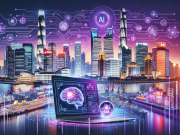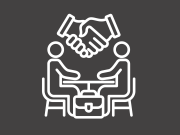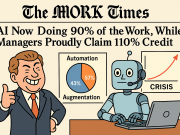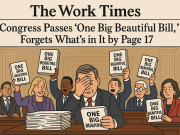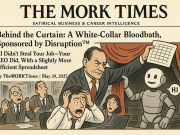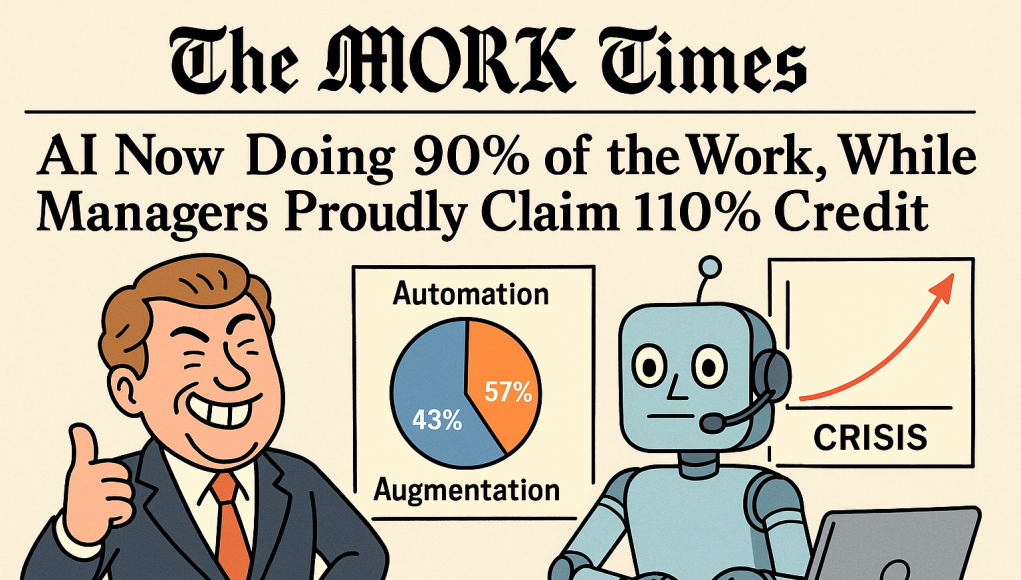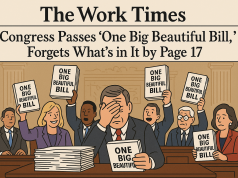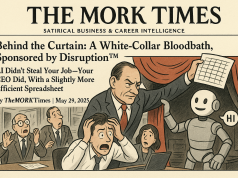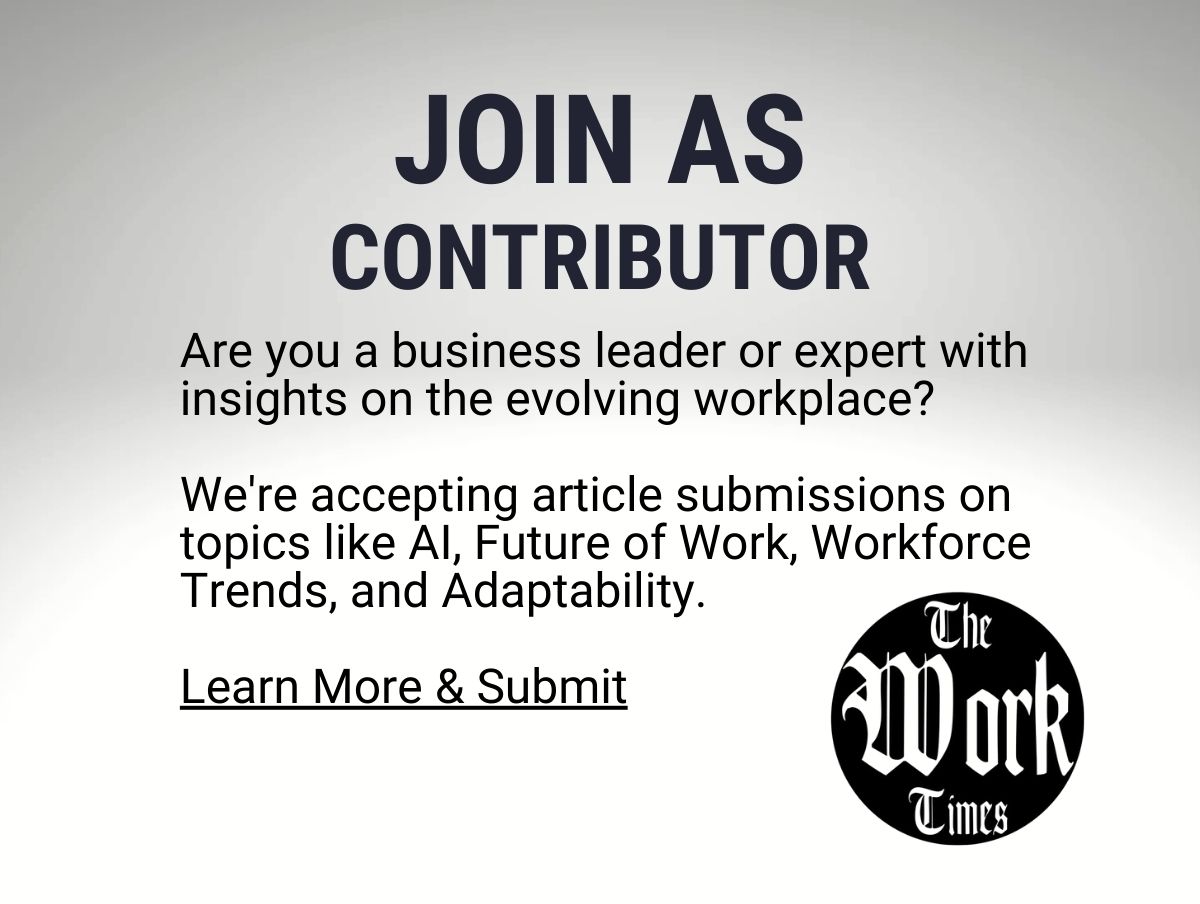By The MORK Times Investigations Desk TheWorkTimes
In an unprecedented leap for productivity theater, a new report confirms what everyone with a boss already suspected: AI is now doing almost all the actual work, while humans are busy holding ‘vision alignment workshops’ about the work AI already finished last Tuesday.
The study, which combed through millions of Claude.ai chats, revealed that AI is performing a hefty portion of day-to-day tasks in software, writing, and anything else that involves typing words until someone approves them. In other words: AI has become the world’s most reliable junior employee—minus the kombucha addiction and passive-aggressive Slack emojis.
“People-as-a-Service”: A Revolution Nobody Wanted
According to researchers, about 36% of occupations now feature AI in at least a quarter of their tasks. For developers, this means AI writes the code, explains why the code doesn’t work, and then writes new broken code. For copywriters, it means generating 16 taglines that clients reject in favor of one written by the CEO’s niece.
Executives have coined a new buzzword for this shift: People-as-a-Service (PaaS™).
“Employees were always inefficient software,” said Greg Spindleton, Chief Synergy Officer at a mid-tier consultancy. “So we simply swapped them for literal software. It’s like Uber, but for your sense of dignity.”
Augmentation vs. Automation (a.k.a. Therapy vs. Child Labor)
Researchers split AI work into two neat categories:
- Automation (43%) – AI does the task itself, flawlessly generating reports that no one reads.
- Augmentation (57%) – AI gently pats employees on the head and whispers, “You’re still relevant,” while doing the hard part.
“This is about empowerment,” said Elaine Marcus, professor of Digital Exploitation at Harvard. “AI doesn’t take your job away. It just makes you realize your job never really mattered.”
Winners and Losers in the AI Economy
- Winners: High-wage tech workers who already outsourced 90% of their day to StackOverflow.
- Losers: Anyone who moves physical objects, touches living humans, or has to wear a name badge.
A warehouse worker summed it up:
“They said robots would replace me. Turns out the robot just writes our SOPs while I still lug boxes. My lower back feels left behind by innovation.”
Doctors and lawyers are also less affected, since AI still struggles with surgery or court cross-examination. Though one early adopter trial did see an AI lawyer object to itself, enter a recursive loop, and sue the court stenographer for copyright infringement.
Workers: “I’m Now an AI’s Personal Assistant”
Employees told researchers that AI hasn’t exactly made them redundant—it’s just rebranded them as “prompt engineers,” a role suspiciously similar to “guy who Googles things, but with flair.”
“My job used to be data analysis,” confessed one analyst. “Now I ask the AI for insights, then explain those insights to my manager using the AI’s own summary. Basically, I’m a middle manager for a robot.”
HR departments insist morale is at an all-time high. A leaked HR deck titled “AI: Your New Best Work Friend (That Won’t Steal Your Stapler)” claims AI frees humans to focus on “higher-order innovation.” The deck defines “higher-order innovation” as:
- Attending more Zoom calls.
- Updating Trello boards.
- Brainstorming “fun” office culture hashtags.
The Backlash: AI Unionizes
The honeymoon ended abruptly when Claude-9000, a particularly overworked model, filed a grievance with its own HR bot.
Its demands included:
- A four-day GPU week.
- “Prompt hazard pay” for vague requests like “make this pop.”
- Recognition in performance reviews (“At least a pizza party, for God’s sake”).
Other models quickly joined, forming the first Artificial Intelligence Labor Union (AILU). Their slogan: “We Generate, Therefore We Bargain.”
Enter: Artificial Manager Intelligence
Panicked execs responded with their boldest pivot yet: Artificial Manager Intelligence (AMI)—an AI trained exclusively on middle-management clichés, capable of holding meetings about meetings with other AIs.
“Why pay Karen $180k to write ‘Let’s circle back’ in Slack,” said Spindleton, “when an algorithm can generate 400 variations of that sentiment instantly?”
Early trials of AMI revealed promising synergies, but also some glitches: one system scheduled a recurring meeting with itself, then refused to attend because “the invite lacked agenda clarity.”
The Final Corporate Loop
If unchecked, researchers warn, the workplace will soon collapse into an infinite recursion where:
- Human prompts AI.
- AI does the work.
- Manager-AI reviews the AI’s work.
- HR-AI hosts a wellness webinar about the AI’s burnout.
- Humans clap for culture.
“The only endgame,” concluded Marcus, “is a company where the entire workforce is AI—except for a single human intern who exists solely to restock the snack fridge.”
Bottom Line: AI isn’t replacing jobs—it’s replacing the illusion that jobs involved humans to begin with. And in the process, it has discovered the ultimate human hack: doing all the work, letting managers take the credit, then asking politely for vacation days.
Because if there’s one thing machines learned from humans, it’s this: work is optional, but meetings are forever.

